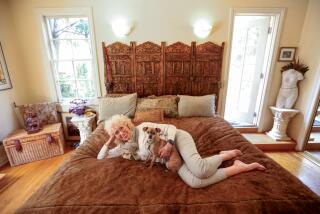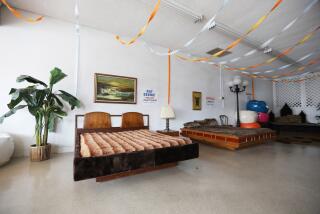A Book About Beds from A to Zzzz : * Repose: There’s little all that modern, and plenty ancient, about where we lay our heads.
- Share via
The words “and don’t let the bedbugs bite” was a legitimate lights-out admonition when beds were made of straw or feathers or leaves.
Beds are much more sanitary now, of course, but they basically are little changed from their ancient Egyptian forebears. They’re still the center of life--conception, birth, sickness, death. Some beds we consider modern aren’t at all.
All of this and more is from Alecia Beldegreen, creative director of Bride’s magazine and author of a new coffee table book, “The Bed,” (Stewart Tabori & Chang, $45).
The modern water bed was introduced in 1967 in California, but water beds were used in hospitals before that to minimize bedsores on long-term patients. All are based on centuries-old counterparts: Persian nomads filled goatskins with water, and ancient Romans used animal skins as water mattresses.
While straw, corncobs and other natural materials of yore have been replaced with inner springs, batting and foam, most beds fit into one of two traditional types. They are either mats on the floor or mattresses on a frame a few inches off the floor. Most bed frames also have box springs, though platform beds, sans box springs, have come to the fore in recent years.
Regardless of type, all beds require maintenance. The simple Eastern futon may look easier to care for than the pillow-and-fabric-swathed Western bedstead, but it isn’t free of trouble. It has to be rolled up and stored every morning.
A capsule history of the rise of the bed starts with bare ground, Beldegreen says: “Human beings began by sleeping on the ground. Later, they gathered leaves and began to make a bed. The earliest beds we know of belonged to the Egyptians. They exist because the Egyptians believed in an afterlife and had beds placed in their sealed tombs so they would have them in the next life.”
During the early Middle Ages, with its surprise attacks on castle and clan, chieftains put the head of the bed at a 45-degree angle off the floor and slept nearly erect. That gave them a fast start in case of attack. They also kept a sword by the bedside and a light burning.
By the 14th Century, canopies and elaborate curtains for privacy and warmth were common among castle dwellers.
History’s most elaborate beds are from France. French monarchs conducted court business while lying in bed, and French ladies received visitors while reclining. Louis XIV is said to have owned 413 beds.
“Vermin were common in wooden beds with straw or feather mattresses,” Beldegreen says. In the late 18th Century, the cast-iron bedstead with cotton mattress was introduced in England and America as a sanitary alternative. That ended the need for the common admonition to “sleep tight and don’t let the bedbugs bite.”
The cabinetmaker Thomas Sheraton introduced twin beds to 18th-Century England. He reasoned that two people sharing a bedroom would be more comfortable if each had his own bed next to the other.
The size of a double bed inched larger into the mid-20th Century. But the Better Sleep Council says it is no longer the size of choice in America, because at 54 by 72 inches it provides little more space per person than a baby’s crib. Now, the council says, queen-size beds at 60 by 90 inches are the most popular purchases; the king-size bed has as much room as a pair of twin beds.
Beldegreen traveled to 10 countries in Europe and the Caribbean in researching her book. a t the Victoria and Albert Museum in London, she encountered the Great Bed of Ware mentioned in Shakespeare’s “Twelfth Night.”
The bed, 18 feet wide and 12 feet long, was the property of an English inn in Ware. Twelve to 20 people could sleep comfortably, and friends would travel en masse in order to share the bed for a night.
At the other end of the scale is a bed at the tiny Vuitton Museum in Paris. It folds up into its own suitcase. The French luggage company made it in 1865 for an explorer named Pierre Savorgnan de Brazza.
Many antique beds are in private hands. Iris Barrel Apfel of New York, for example, furnishes the bedrooms of her home with antique beds. She also hangs old cradle boards on the wall and uses old cribs and cradles as accessories throughout the house. Photographs from Apfel’s home are included in Beldegreen’s book.
If you’re looking for an old bed, shop the antique stores. But Beldegreen warns that they are often more trouble than they’re worth.
“They are rare and expensive and often have to be reinforced before they can be used,” she says. “Furthermore, they generally don’t fit contemporary mattresses, and the bed linens have to be custom made.”
If you must have an antique, it’s simpler to buy only the headboard and attach it to a modern mattress and box springs. Or buy a reproduction.
“In the last few years,” she says, “reproductions of everything from 18th-Century French beds to Biedermeier and Shaker beds have become available.”


